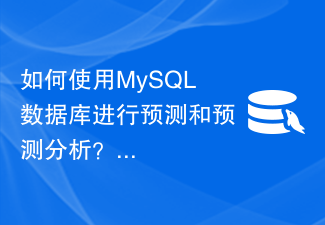How to use Go language for code logging and analysis
Introduction:
Logging is an indispensable part of software development. By recording key operating information, we can discover and solve problems in time, and also help with system maintenance and performance analysis. This article will introduce how to use Go language for code logging and analysis.
1. Logging
- Use the log package in the standard library
The standard library of the Go language provides the log package for basic logging. Simple logging functions can be implemented by setting different prefixes, output locations and priorities.
Sample code:
package main
import (
"log"
"os"
)
func main() {
// 创建一个新的日志记录器
logger := log.New(os.Stdout, "INFO: ", log.Ldate|log.Ltime|log.Lshortfile)
// 输出日志
logger.Println("This is a log message.")
}- Using third-party libraries
In addition to the log package in the standard library, there are many open source log libraries available in the Go language community choose. These libraries provide richer logging capabilities and more flexible configuration options that can be selected based on specific needs.
Commonly used log libraries include logrus, zap, zerolog, etc. The following takes logrus as an example to show how to use a third-party log library.
Sample code:
package main
import (
log "github.com/sirupsen/logrus"
)
func init() {
// 设置日志格式为JSON格式
log.SetFormatter(&log.JSONFormatter{})
// 设置日志级别为info以上
log.SetLevel(log.InfoLevel)
// 输出日志到标准输出
log.SetOutput(os.Stdout)
}
func main() {
// 输出日志
log.Info("This is a log message.")
}2. Log analysis
- Basic log analysis
Using logs for system analysis can help find and solve problems, such as Find potential performance issues, discover unusual behavior, and more. You can use existing log analysis tools such as ELK Stack (Elasticsearch, Logstash, Kibana) or Splunk, etc.
Sample code:
# Logstash配置文件
input {
file {
path => "/var/log/golang/app.log"
start_position => "beginning"
}
}
filter {
json {
source => "message"
}
}
output {
elasticsearch {
hosts => ["localhost:9200"]
index => "golang-app-logs"
}
stdout { codec => rubydebug }
}- Customized log analysis
For some specific needs, we may need to customize the log analysis function. In Go language, you can use regular expressions or related libraries (such as regexp or github.com/logrusorgru/regexp2) to implement customized log analysis.
Sample code:
package main
import (
"fmt"
"regexp"
)
func main() {
// 日志消息
logMessage := `[2022-01-01 10:00:00] ERROR: This is an error message.`
// 匹配时间和日志级别
r := regexp.MustCompile(`[(.*?)] (.*?):`)
result := r.FindStringSubmatch(logMessage)
// 输出结果
fmt.Println("Timestamp:", result[1])
fmt.Println("Level:", result[2])
}Conclusion:
This article introduces how to use Go language for code logging and analysis. Through the standard library or third-party libraries, we can easily implement basic logging functions. Using existing log analysis tools or custom analysis methods can help us better understand and optimize system performance. I hope this article can provide readers with some help in logging and analysis.
The above is the detailed content of How to use Go language for code logging and analysis. For more information, please follow other related articles on the PHP Chinese website!
 如何使用MySQL数据库进行预测和预测分析?Jul 12, 2023 pm 08:43 PM
如何使用MySQL数据库进行预测和预测分析?Jul 12, 2023 pm 08:43 PM如何使用MySQL数据库进行预测和预测分析?概述:预测和预测分析在数据分析中扮演着重要角色。MySQL作为一种广泛使用的关系型数据库管理系统,也可以用于预测和预测分析任务。本文将介绍如何使用MySQL进行预测和预测分析,并提供相关的代码示例。数据准备:首先,我们需要准备相关的数据。假设我们要进行销售预测,我们需要具有销售数据的表。在MySQL中,我们可以使用
 如何使用 Go 语言进行数据可视化分析?Jun 10, 2023 am 10:46 AM
如何使用 Go 语言进行数据可视化分析?Jun 10, 2023 am 10:46 AM随着大数据时代的到来,数据可视化分析在各行各业中扮演着至关重要的角色。而Go语言作为一种快速、高效、安全的编程语言,也逐渐在数据可视化分析领域占据一席之地。本文将探讨如何使用Go语言进行数据可视化分析。一、Go语言常用的数据可视化库Plotly:可用于在浏览器中创建交互式的图形,支持多种图形类型,如线图、条形图、散点图、热力图等。Gonum/plo
 Linux下的实时日志监控与分析Jul 29, 2023 am 08:06 AM
Linux下的实时日志监控与分析Jul 29, 2023 am 08:06 AMLinux下的实时日志监控与分析在日常的系统管理和故障排查中,日志是一个非常重要的数据来源。通过对系统日志的实时监控和分析,我们可以及时发现异常情况并进行相应的处理。本文将介绍Linux下如何进行实时日志监控和分析,并提供相应的代码示例。一、实时日志监控在Linux下,最常用的日志系统是rsyslog。通过配置rsyslog,我们可以实现将不同应用程序的日志
 如何使用PHP进行性能分析和调优Jun 06, 2023 pm 01:21 PM
如何使用PHP进行性能分析和调优Jun 06, 2023 pm 01:21 PM作为一种流行的服务端语言,PHP在网站开发和运行中扮演着重要的角色。然而,随着PHP代码量的不断增加和应用程序的复杂性提高,性能瓶颈也越来越容易出现。为了避免这种问题,我们需要进行性能分析和调优。本文将简单介绍如何使用PHP进行性能分析和调优,为您的应用程序提供更高效的运行环境。一、PHP性能分析工具1.XdebugXdebug是一款广泛使用的代码分析工具,
 最近大火的Diffusion Model,首篇扩散生成模型综述!Apr 09, 2023 pm 08:31 PM
最近大火的Diffusion Model,首篇扩散生成模型综述!Apr 09, 2023 pm 08:31 PM本综述(Diffusion Models: A Comprehensive Survey of Methods and Applications)来自加州大学&Google Research的Ming-Hsuan Yang、北京大学崔斌实验室以及CMU、UCLA、蒙特利尔Mila研究院等众研究团队,首次对现有的扩散生成模型(diffusion model)进行了全面的总结分析,从diffusion model算法细化分类、和其他五大生成模型的关联以及在七大领域中的应用等方面展开,
 如何使用 Go 语言进行大数据分析?Jun 11, 2023 am 11:11 AM
如何使用 Go 语言进行大数据分析?Jun 11, 2023 am 11:11 AM随着数据规模逐渐增大,大数据分析变得越来越重要。而Go语言作为一门快速、轻量级的编程语言,也成为了越来越多数据科学家和工程师的选择。本文将介绍如何使用Go语言进行大数据分析。数据采集在开始大数据分析之前,我们需要先采集数据。Go语言有很多包可以用于数据采集,例如“net/http”、“io/ioutil”等。通过这些包,我们可以从网站、API、日志
 如何利用PHP和Elasticsearch实现结果聚合和分析Jul 17, 2023 pm 01:05 PM
如何利用PHP和Elasticsearch实现结果聚合和分析Jul 17, 2023 pm 01:05 PM如何利用PHP和Elasticsearch实现结果聚合和分析引言:随着互联网和信息技术的迅猛发展,数据量的爆炸式增长使得数据的存储、处理、分析变得越来越重要。而Elasticsearch作为一个开源的分布式搜索和分析引擎,具有强大的全文检索、实时分析和数据聚合能力,已经被广泛应用于各大行业中。在本文中,我们将介绍如何利用PHP和Elasticsearch结合


Hot AI Tools

Undresser.AI Undress
AI-powered app for creating realistic nude photos

AI Clothes Remover
Online AI tool for removing clothes from photos.

Undress AI Tool
Undress images for free

Clothoff.io
AI clothes remover

AI Hentai Generator
Generate AI Hentai for free.

Hot Article

Hot Tools

EditPlus Chinese cracked version
Small size, syntax highlighting, does not support code prompt function

SublimeText3 Chinese version
Chinese version, very easy to use

DVWA
Damn Vulnerable Web App (DVWA) is a PHP/MySQL web application that is very vulnerable. Its main goals are to be an aid for security professionals to test their skills and tools in a legal environment, to help web developers better understand the process of securing web applications, and to help teachers/students teach/learn in a classroom environment Web application security. The goal of DVWA is to practice some of the most common web vulnerabilities through a simple and straightforward interface, with varying degrees of difficulty. Please note that this software

PhpStorm Mac version
The latest (2018.2.1) professional PHP integrated development tool

Dreamweaver CS6
Visual web development tools







